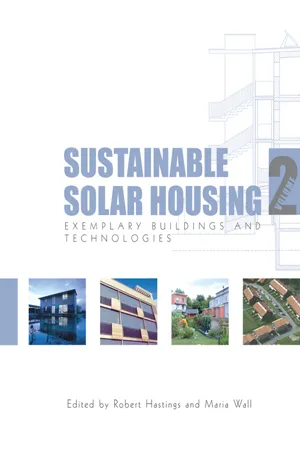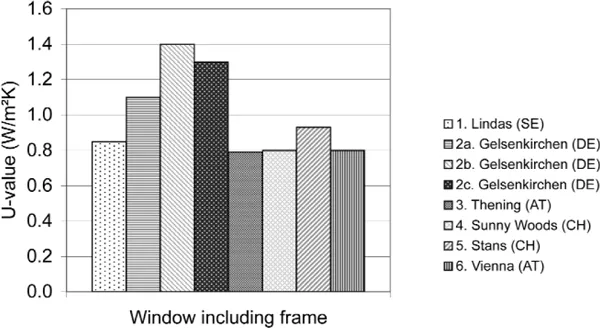![]()
Part I
EXEMPLARY
BUILDINGS
![]()
1
Overview
Daniela Enz and S. Robert Hastings
1.1 The Diversity of the Projects
It is interesting to observe how the different strategies and technologies presented in this book have been applied by designers in exemplary housing projects, and with what degree of success. Six projects from Sweden, Germany, Austria and Switzerland are documented in this chapter. Three building types are represented: single family detached housing, row housing and apartment blocks. This overview shows what absolute values are achieved, as well as the ranges. Except for the housing in Gelsenkirchen, the projects all achieve extremely low primary energy use for space and water heating, including electricity for technical systems (see Figure 1.1.1). It is also interesting to observe that the energy consumed to heat DHW is more or less equal to that required for space heating.
Each project has its own distinct features. While one architect focused mainly on finding and demonstrating an economical solution on how to construct a Passivhaus building, the others strived to develop sophisticated energy concepts, optimizing ecological aspects or integrating solar technologies within the building design.
Note: The total primary energy demand for the system includes heating, domestic hot water, pumps and fans. Household electricity is not included. Source: AEU Ltd, Wallisellen
Figure 1.1.1 Energy demand
1.2 Building Envelope and Construction
All six projects are located either in a cold or temperate climate, where a compact building form with a well-insulated and air-tight building envelope with minimized thermal bridges is essential to reduce heat losses through transmission or air leakage. The high quality of the building envelopes is shown in Figure 1.2.1. Except for the low energy project, Gelsenkirchen, the U-values for walls, roof and floor range from 0.10 to 0.15 W/m2K.
Note: The mean U-value weighted for the building envelope includes walls, roof, floor, windows and doors. It is the weighted average U-value for the entire envelope in m2 of surface.
Source: AEU Ltd, Wallisellen
Figure 1.2.1 U-values of the building envelope components
High quality windows are equally important. The U-values for the windows, including the frame and glazing, range from to 0.64 to 0.9 W/m2K, except for the low energy buildings in Gelsenkirchen. The two projects, Sunny Woods and Stans, both have good U-values for the walls, roof and floor; but the overall average U-values for the whole envelope are not among the best. This is because these projects have large window areas. To be fair, the passive solar gains must be considered relative to the worsening of the overall envelope U-values for these projects. As can be seen in Figure 1.2.2, all projects have high quality windows.
A preference for prefabricated, lightweight constructions or mixed constructions can be observed in our documented projects. A method called cumulative energy demand (CED) was applied to compare these two constructions. It quantifies energy use over the whole life cycle of a house, from manufacturing of materials through construction, operation and, finally, demolition. This total picture can be very revealing, as seen in Chapter 3 on the solar energy housing estate Gelsenkirchen, with its 71 houses.
Source: AEU Ltd, Wallisellen
Figure 1.2.2 Window U-values
1.3 Technical Systems
Almost all of the analysed buildings have a solar thermal system. Flat-plate collectors or vacuum collectors are integrated either in the façade or placed on the roof. The very low remaining space heating demand of these buildings makes the energy needed for domestic water heating an important end use. A solar DHW or combined DHW and space heating system further reduce the consumption of non-renewable energy.
Four of the six projects have a grid-connected photovoltaic (PV) installation on the roof. The power supplied by the systems ranges from 1 kWp (kilowatt peak) up to over 16 kWp. Different PV technologies as thin film, poly-crystalline or mono-crystalline solar cells were used. In low energy buildings, electricity represents a considerable part of the energy balance, especially if this is considered in units of primary energy.
All projects have a mechanical ventilation system with heat recovery. The efficiency of the systems range from 80 per cent to 95 per cent. Three projects have earth pipes to preheat the supply of fresh air. This prevents the heat exchanger from freezing during very low temperatures.
T...



